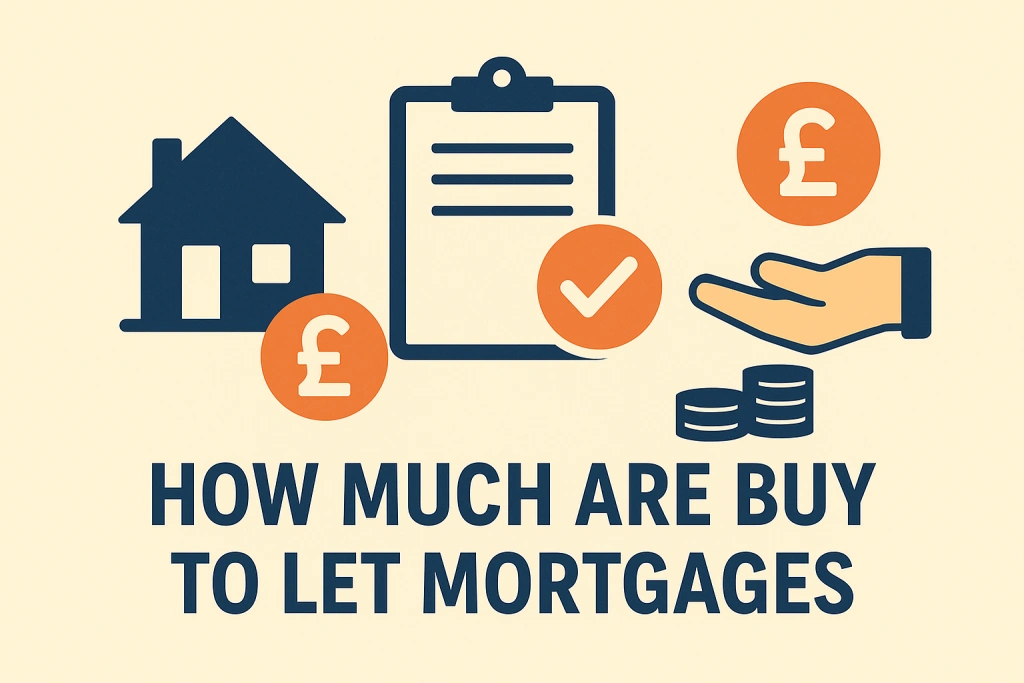Investing in property can be rewarding, but one of the first questions potential landlords ask is how much is a buy to let mortgage? The answer depends on a number of factors, including the size of your deposit, the property’s value, the interest rate offered, and the rental income expected.
Understanding these details is crucial before taking the next step. This guide explains how buy to let mortgages work, how much deposit for a buy to let mortgage is usually required, and what costs to consider beyond the monthly repayment.
How much is a buy to let mortgage?
Buy to let mortgages are designed for rental properties, not homes you plan to live in. They are structured differently to residential mortgages and usually come with:
- Larger deposit requirements
- Higher interest rates
- Stricter affordability checks
So, how much is a buy to let mortgage? In most cases, lenders will want to see that the property’s rental income can comfortably cover the mortgage repayments. Many use a calculation that requires rent to be 125–145% of the monthly repayment.
Your loan’s affordability depends on your deposit, property value, and the rent it will likely generate.

How much deposit for a buy to let mortgage?
A key concern for investors is how much deposit for buy to let mortgage products lenders expect. The general rule is:
- Standard minimum deposit: 25% of the property’s value
- In some cases: 20% if rental income is very strong and criteria are met
- For high-value or specialist products: 30–40% deposit may be required
For example, if you are asking how much deposit on a buy to let mortgage for a £200,000 property, you will typically need £50,000 upfront. For a £300,000 property, you will usually need at least £75,000.
This threshold is much higher than residential mortgages, where deposits often start from 5–10%.
Why are deposits higher?
Lenders view rental properties as higher risk compared with owner-occupied homes. Tenants can move out at short notice, properties may sit empty, and landlords must deal with ongoing maintenance.
By requiring larger deposits, lenders reduce their risk. For borrowers, this creates more equity in the property, which can also work in your favour. A larger deposit often secures better rates and lower monthly repayments.
Factors that affect the cost
The total cost of a buy to let mortgage depends on several elements:
- Deposit size – larger deposits reduce interest rates and repayments
- Property value – higher values mean higher deposits and bigger loans
- Rental income – must comfortably exceed repayments for approval
- Interest rates – typically higher than residential deals
- Fees – including arrangement charges, valuation fees and legal costs
When you ask how much is a buy to let mortgage, the answer always depends on these combined factors rather than a single figure.
Costs beyond the deposit
When planning your investment, it is important to look past the deposit. Costs to budget for include:
- Stamp duty on additional properties
- Letting agent fees if you outsource management
- Ongoing repairs and maintenance
- Landlord insurance
- Tax on rental profits
These expenses can add up quickly, so they should be considered when working out affordability.
Example scenarios
To illustrate how much deposit for buy to let mortgages may be needed, here are some simple examples:
- £180,000 property – with a 25% deposit, you need £45,000 upfront. The mortgage covers £135,000, and the lender expects rent to exceed repayments by at least 25%.
- £250,000 property – with a 30% deposit, you need £75,000. A mortgage of £175,000 is taken, with rental income assessed at 145% of repayments.
- £400,000 property – with a 40% deposit, you need £160,000. Larger loans often mean stricter rental coverage checks, but rates may be lower.
These examples show why asking how much deposit for a buy to let mortgage depends on both lender policy and the property itself.
Pros of buy to let mortgages
- Opportunity to create rental income
- Long-term potential for property value growth
- Ability to retain a property asset while earning returns
- Flexibility to expand into property investment
Cons of buy to let mortgages
- Higher deposits than residential mortgages
- Higher interest rates and stricter rental income checks
- Extra costs such as maintenance, insurance and compliance
- Rental voids may reduce income and affect affordability
FAQs on buy to let mortgage costs
How much deposit for a buy to let mortgage is standard?
Most lenders require 25%, though the range is usually 20–40%.
How much is a buy to let mortgage compared with a residential one?
They are generally more expensive, with higher deposits and higher rates.
Can I get a buy to let mortgage with a 10% deposit?
It is extremely unlikely. 20% is the absolute minimum, but 25% is standard.
Do I need personal income as well as rental income?
Some lenders expect applicants to show other sources of income, while others rely mainly on rental yield.
Does a bigger deposit reduce costs?
Yes. A larger deposit lowers loan-to-value ratios, often securing better rates and smaller monthly repayments.
Final thoughts
So, how much is a buy to let mortgage? The answer depends on your deposit, your property value, and your expected rental income. In most cases, you will need at least a 25% deposit, and lenders will want rental income to cover repayments by a healthy margin.
By understanding how much deposit for buy to let mortgage products is typically needed and planning for additional costs, you can make a more informed decision about whether buy to let is right for you and start the application process. Envelop Finance can guide you through the process, helping you compare lenders, assess affordability, and choose a product that suits your goals.



